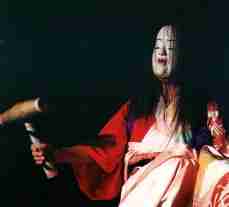[Contents] [Back] [Next] [Section VIII: Kagura in Northern Hiroshima Prefecture]
Ueda Kagura
There are no reference works available on the origins of Ueda Kagura, but the Ueda Hachiman Shrine was built over 460 years ago and according to legend, sacred dances have been performed there throughout its history. People from surrounding villages learned the dances and then passed them down to their children. Characteristics of Ueda Kagura include simple costumes, subdued dancing, and many lyrics. The influence of Ueda Kagura can be seen in Kagura performed at the Gogyôsai (Festival of the Five Elements) held in the Ashita River basin (formerly Bingo, now eastern Hiroshima Prefecture) and the Numata River basin (formerly East Aki, now western Hiroshima Prefecture). Today all that is left of this festival is Kagura. A movement began in 1975 to revive folk performing arts, and is now known as the Ueda Society for the Preservation of Performing Arts. People learned the dances from a local teacher and invited teachers of the same type of Kagura from neighboring towns and studied their dances as well. They combined these dances with Kagura from different schools in search of a performance that will meet the demands of changing times. |
|
NPO Hiroshima kagura Art Laboratory |
